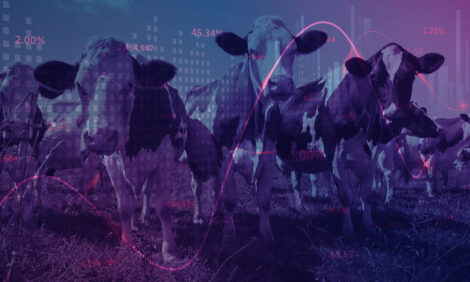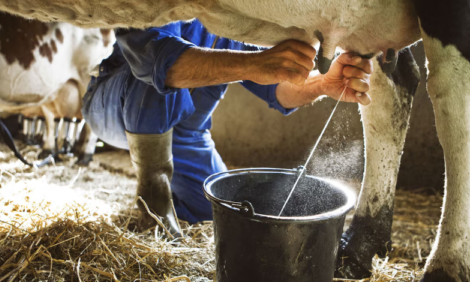



ADM’s holistic consulting helps dairy farmers navigate tight margins
Milk prices are expected to decline; ADM says small management tweaks can add pounds of milk and protect profitability
Dr. Brian Lammers, a dairy nutritionist at ADM Animal Nutrition, and Bryant Johnson, a dairy specialist from ADM Animal Nutrition, were recently interviewed by The Dairy Site’s Sarah Mikesell about ADM’s holistic herd consultation services.
Dr. Lammers, how do ADM's consultative services help dairy producers optimize herd health and productivity?
Each dairy farm is unique in what they have for their facilities, for example how they're housing cattle, their grouping strategies, milking frequency as well as the forages on the farm. We work with farms to help customize different feeding strategies and nutrition targets of each ration. We also evaluate their farm to look for ways to improve efficiency and performance.
We read and study the latest research that's coming out of universities as well as the research that we do at ADM to learn different nutrition approaches and products that can help improve the performance and health of cattle. In the end, we are finding ways to improve performance, profitability and efficiency while converting dry matter to milk. We're constantly looking for opportunities, which is very important at the present time because we're going into a concerning, challenging time right now.
It looks like milk prices, based on milk futures, are going to be falling, maybe as much as $2 per hundredweight and with that will come economic pressure on dairy farms. We can help evaluate farms by looking at strategies they use as management practices and how they can best utilize their feed. With our recommendations on feeding strategies, farms can improve performance and profitability that can help them get through these challenging times that are inevitably coming toward us.
There are always highs and lows – pricing cycles that producers experience, correct?
Correct, there are going to be pressures and challenges. We're here to collaborate with dairy producers one-on-one to evaluate their farms and their situation and see what we can do to improve their efficiencies and profitability during both good and difficult times.
Bryant, what are some of the most common challenges dairy producers face and how does ADM help address these issues?
Along with tighter margins that are coming, producers also must balance their feed inventories and look for efficiencies and ways to capitalize inside their farms. We will run a lot of tests on feedstuffs. We walk a lot of cows, check fecal starch levels for digestibility and check how the total mixed ration (TMR) is mixed and delivered by performing TMR audits and running TMR samples. We always look for those efficiencies to capitalize on profitability and help farmers get through these low points.
Can you share examples of how ADM's recommendations have led to improvements in cow health and milk production?
We’ve recommended installing cameras in barns to monitor cow flow and feed push-ups. We also conduct TMR audits, which include assisting with inventory management, evaluating mixing processes, and monitoring feed push-ups.
We've had situations where monitoring daily activities and management practices have led to improvements of more than 7 lbs. of milk – just by making simple management changes such as changing the order of how they're adding ingredients into their mixers; how many pushups a day they're adding; and adding moisture to the TMR. All those things come into play when we are looking for improvements on the farm.
Dr. Lammers, how does ADM tailor its feeding programs and rations to meet the specific needs of different dairy operations such as herd size, forage availability or regional challenges?
Every farm is different, and we're specifically trying to look at a farm’s grouping strategies and if they are delivering the right nutrition to each group of cows. For example, if they have a one-group dry cow or a two-group dry cow program, a fresh pen or a pregnant pen, we can feed those pens differently to optimize the health, efficiency, and profitability of each pen.
We’re also looking closely at a farm’s forages because different years have different weather effects on forages which can impact the digestibility of available nutrients. We can tailor our recommendations based on our experience and research to optimize ingredients and nutrients delivered in the ration to help the cow reach her genetic performance potential.
Another part that we also tailor is considering what dairy producers are getting paid for in their milk. For example, In the southeastern United States, they're paid on volume plus their premium for fat. They get no additional value for milk protein content. Therefore, we don't use specific nutrition strategies that have added cost to boost milk protein. We let the cow produce the natural amount of milk protein without supplementation strategies that offer a boost.
In the last two years, milk fat has had a very high value, and we've been using strategies and products to boost milk fat. But looking at milk prices in particular, the value of milk fat has been dropping in the future’s prices. So, we're looking at changing our nutrition approach to lower the cost of a ration because we're not going to get the full value of specific strategies that we may use to get the value from the milk fat.
We're constantly looking for those small tweaks that we can make to help farms be more profitable based upon their resources, their on-farm ingredients, what comes in their milk check and how that's calculated. Sometimes the margins are minimal, but even a small tweak can make a significant impact on the sustainability of a farm.
The devil's in the details sometimes, right?
It sure is, and the best farms work very closely with us to improve their efficiency and profitability. It's never just them or us – the best performing and most profitable farms are the ones that we have a very close relationship with. We stay in tune with what’s happening on the farm and provide recommendations on what can be done to tighten the screws down to help them become a little bit more profitable because the difference between some of these farms and their profitability – it’s not much. As Bryant said, very tight margins are coming.
It's finding every ounce of efficiency you can, right?
Yes, it is. Some farms take advantage of that, and we can help them in the barn. Of course, the key thing we offer is nutrition strategies, but we can also help them look for opportunities and new ideas in the barn on how they're feeding their cows or perhaps simply identifying different grouping strategies – whatever it might be – to help make an additional improvement.



